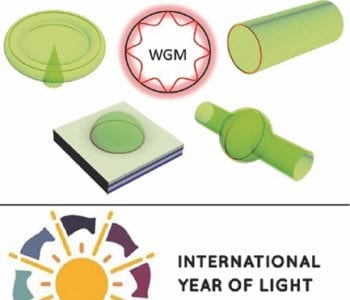2015 is the International Year of Light, proclaimed by the United Nations to recognize the achievements of light science and its applications, and its contributions to humankind. It will raise special attention for major topics and key technologies in the field of optics and photonics. Advanced Optical Materials contributes to this goal through publishing a special series of outstanding review articles.
 One of the key issues in all photonic or optoelectronic devices is light management or the control of light-matter interaction. A microcavity is a typical optical component which confines light in a small volume and hence enhances light-matter interaction. Among all configurations, whispering gallery mode (WGM) microcavities, which provide strong optical confinement via total internal reflection, present unique optical performances. The bidirectional light propagation in a WGM cavity and the evanescent field spanning several hundred nanometers can be exploited for novel applications such as bio- or chemical sensing, microlasers, information processing, on-chip communication and more. Moreover, in fundamental research, coupled ring cavities based on WGM can be applied to explore new physical phenomena like complex networks, topological insulators, reciprocity and parity-time symmetry.
One of the key issues in all photonic or optoelectronic devices is light management or the control of light-matter interaction. A microcavity is a typical optical component which confines light in a small volume and hence enhances light-matter interaction. Among all configurations, whispering gallery mode (WGM) microcavities, which provide strong optical confinement via total internal reflection, present unique optical performances. The bidirectional light propagation in a WGM cavity and the evanescent field spanning several hundred nanometers can be exploited for novel applications such as bio- or chemical sensing, microlasers, information processing, on-chip communication and more. Moreover, in fundamental research, coupled ring cavities based on WGM can be applied to explore new physical phenomena like complex networks, topological insulators, reciprocity and parity-time symmetry.
Therefore, designing and engineering WGM microcavities with innovative geometries and functionalities have attracted tremendous research interests in the past two decades. In this review article, Handong Sun (Nanyang Technological University, Singapore) and co-workers present the pioneering techniques and breakthrough discoveries in the field of WGM microcavities, including the evolution of fabrication methodologies ranging from melting glassy materials in early studies to recent top-down and bottom-up approaches for semiconductors as well as flexible soft matter processing methods. With the presented techniques WGM microcavities and microlasers with a variety of geometries like microsphere, microdisk, microring, microtoroid, hemisphere, microfiber, and core-shell structure can be produced. Also, some representative applications of WGM microcavities are reviewed from the aspects of wavelength manipulation, sensitive sensing, optical coupling and other prospective fields. Futhermore, the history, fundamental equations and characters are introduced in order to create a better understanding of the WGM microcavities and their applications.
The full series can be found at www.advopticalmat.de/IYL. All articles are published in Advanced Optical Materials and added to this virtual issue over the year.

















